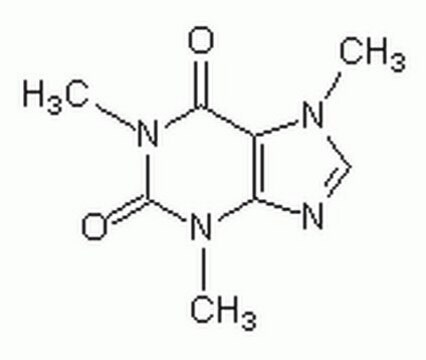W222402
Caffeine
anhydrous, 99%, FCC, FG
Synonym(s):
1,3,7-Trimethylxanthine
About This Item
Recommended Products
biological source
synthetic
Quality Level
grade
FG
Halal
Kosher
anhydrous
reg. compliance
EU Regulation 1334/2008 & 178/2002
FCC
FDA 21 CFR 182.1180
assay
99%
form
powder
mp
234-236.5 °C (lit.)
solubility
H2O: soluble 18.7 g/L at 16 °C
application(s)
flavors and fragrances
documentation
see Safety & Documentation for available documents
food allergen
no known allergens
organoleptic
odorless
SMILES string
CN1C(=O)N(C)c2ncn(C)c2C1=O
InChI
1S/C8H10N4O2/c1-10-4-9-6-5(10)7(13)12(3)8(14)11(6)2/h4H,1-3H3
InChI key
RYYVLZVUVIJVGH-UHFFFAOYSA-N
Gene Information
human ... ADORA1(134) , ADORA2B(136) , ADORA3(140) , PDE4B(5142)
mouse ... Adora2b(11541)
rat ... Adora1(29290) , Adora2a(25369)
Looking for similar products? Visit Product Comparison Guide
Related Categories
General description
Application
- Anti-hair loss effect of a shampoo containing caffeine and adenosine.: Discusses the efficacy of a shampoo formulated with caffeine and adenosine in reducing hair loss, underscoring caffeine′s role in enhancing hair follicle activity and promoting hair health (Chen et al., 2024).
Related product
signalword
Warning
hcodes
Hazard Classifications
Acute Tox. 4 Oral
Storage Class
11 - Combustible Solids
wgk_germany
WGK 1
ppe
dust mask type N95 (US), Eyeshields, Faceshields, Gloves
Choose from one of the most recent versions:
Already Own This Product?
Find documentation for the products that you have recently purchased in the Document Library.
Customers Also Viewed
Our team of scientists has experience in all areas of research including Life Science, Material Science, Chemical Synthesis, Chromatography, Analytical and many others.
Contact Technical Service




